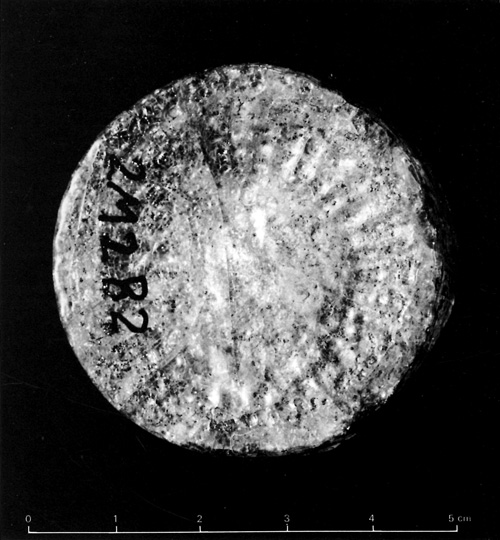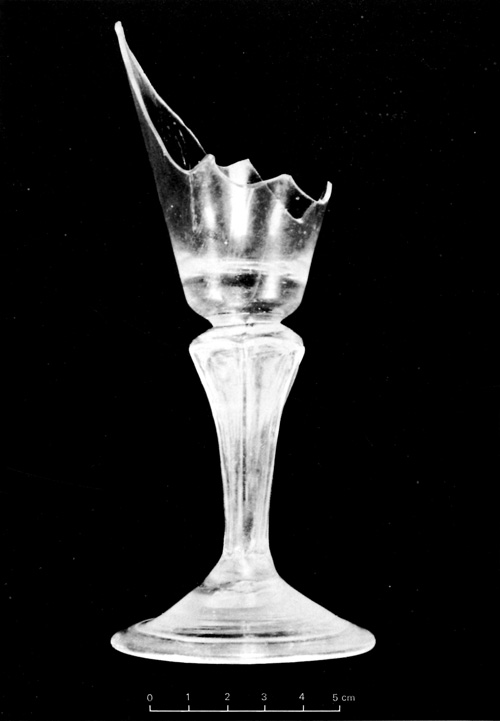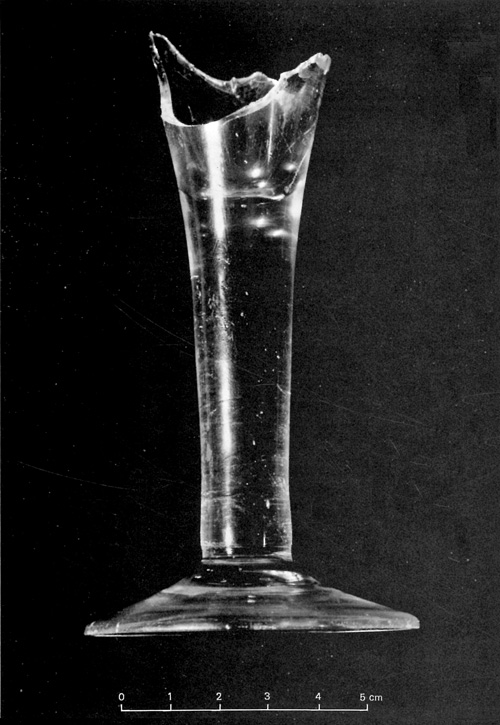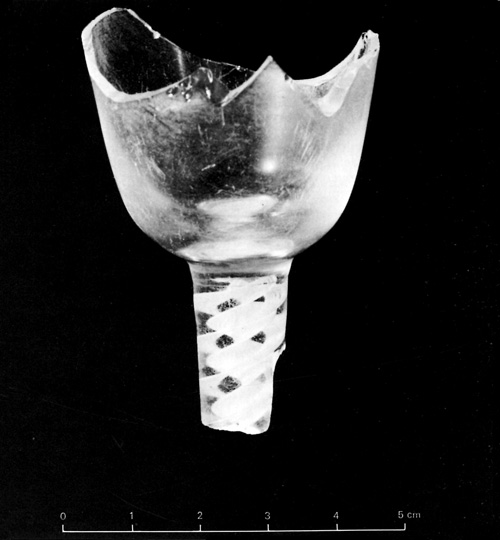|
|
 |
Canadian Historic Sites: Occasional Papers in Archaeology and History No. 16
Table Glass from the Wreck of the Machault
by Paul McNally
The Glass
Table glass of French origin was restricted to one tumbler base,
badly crizzled and decomposed, and many hundreds of wine glasses of a
single type. There were in addition eight wine glasses of English
origin.

1 Base view of a small pattern-moulded French tumbler in crizzled
non-lead metal; mid-18th century.
(Photo by G. Lupien.)
|
The tumbler base (Fig. 1) is from a small pattern-moulded ribbed
non-lead tumbler typical of those manufactured in central and western
France in the middle of the 18th century (Charleston 1952: 18). The
crizzling is characteristic, and so is the tendency to turn brown or
pink in the course of decomposition. Similar tumblers are normal finds
at French sites in Canada with comparable occupation periods: the
Fortress of Louisbourg, Forts Beauséjour and Gaspereau, and Beaubassin
for instance.
No vessel count of the French stemware was undertaken because ice and
tidal action have reduced most of the examples to fragments and because
continuing excavations at the site produce more and more specimens. The
glasses so far probably number close to a thousand, with no significant
variation between examples except that stem height differs slightly.
Capacity appears to be uniform. Shown in Figure 2 is the only wine glass
complete to a segment of the lip rim. The main feature is a hollow
six-sided moulded pedestal stem. The French called the form bouton
carré and evidently borrowed it from Bohemian glassmakers (Barrelet
1957: 114) though English collectors have long referred to such stems as
"Silesian." The glasses are of three-piece construction: the moulded
stem was welded to a round funnel bowl with a thick base, and a plain
conical foot was formed on the stem. In every case the foot has a folded
rim. In many cases the lower part of the stem is twisted slightly from
reheating the stem and attaching the foot; the variation in stem height
results from the same process. The glass has no lead content.

2 French wine glass with hollow six-sided moulded pedestal stem
(bouton carré) and round fennel bowl, non-lead metal; third
quarter 18th century.
(Photo by G. Lupien.)
|
Hollow pedestal stems were a normal French form of stemware in 1760.
They were common at the Fortress of Louisbourg, and some examples
recovered there were certainly deposited in the 1750s (Dunton: pers.
com.). Engraved examples illustrated by Barrelet (1957: Fig. 21) and
Haynes (1964: Pl. 62g) bear the dates 1758 and 1746 respectively.
Haynes remarks that it is not impossible that such glasses are English
(1964: 219). One might add that is it not probable either. While
engraved dates are not necessarily accurate, the size of the
Machault sample indicates the form's great popularity in the
third quarter of the 18th century.
The French wine glasses were scattered throughout the wreck, but were
concentrated on the port side, adjacent to the keelson and well forward.
The very number of glasses is sufficient to indicate that they were
cargo, and additional evidence is the fact that the feet show no wear,
which would have been the case had they been used to any extent. Why
they were included in the cargo is unclear. Documentary research has not
disclosed them among items requested from the crown by threatened
Montreal, nor among items actually shipped although wine of several
varieties does figure in both lists (Beattie 1968). The enterprise was
mounted by the crown, but evidently merchants and ships' officers could
speculate privately in commodities such as glass.
English stemware is represented by seven drawn plain stems with
trumpet bowls and a fragment from a glass with an opaque-twist stem. All
are of lead metal.
The tall plain-stemmed glasses were a fashionable style from about
1735 until the early 1760s in England (Hughes 1956: 88-9).
Rudimentary plain-stemmed wine glasses were in use as common ware
throughout the century and later, but there is a clear distinction
between these short-stemmed and usually clumsily made glasses, and those
made during the period in which the style was fashionable. Of the latter
it has been remarked: "Some would say that this [is] one of the most
beautiful English glasses ever designed" (Lloyd 1969: 60). The
Restigouche examples (Fig. 3), though they have lost most of their bowls,
show some of the gracefulness implied. They are drawn, or two piece,
glasses.

3 English wine glass with drawn plain stem, lead metal; fashionable
about 1735-65.
(Photo by G. Lupien.)
|
Opaque-twist stems enjoyed popularity in England from 1750 until 1780
(Thorpe 1969: 213-4). The stems were formed separately: cylinders of
glass in which enamel rods were imbedded were enclosed by an extra
gather of metal, then drawn and twisted to form long canes subsequently
broken into appropriate lengths. The Restigouche example has a round
funnel bowl and a double-series twist formed of a central and a
surrounding corkscrew, both in white (Fig. 4).

4 English wine glass with round funnel bowl, opaque double-series twist
stem, lead metal; 1750-80.
(Photo by G. Lupien.)
|
The presence of English glass in the French wreck requires some
explanation. Before embarking on a lengthy discussion, and lest it be
argued that too much is made of a chance occurrence, it should be
pointed out that the presence of English table glass at sites with
mid-18th century French contexts is a continuing phenomenon, witnessed
with certainty at the Fortress of Louisbourg and again at Fort
Beauséjour (McNally 1971:123). The converse is not true, or at least has
not shown itself to date.
In general, English glass deposited in French contexts probably came
from several sources. The French writer Paul Bosc d'Antic wrote in 1760:
"L'étranger consomme les quatres cinquièmes des glaces angloises . . .
aujourd'hui ils nous fournissent des lustres, des lanternes, des verres
à boire, des verres d'optique de toute grandeur, &c." (1780: 59).
This is evidence enough of a thriving if one-sided trade in glass
between France and England, and glass so obtained might easily be
forwarded from France to her possessions. Doubtless at least some glass
was brought to Acadia by New England traders (Clark 1968:180-2). Still
more could have been booty.
The most famous contemporary French observations on English table
glass come once again from Bosc d'Antic in 1760. They form as poor a
notice as a patriot might fashion against pernicious foreign
manufactures.
Les Anglois ne doivent point se flatter. . . . Leur cristal n'est
pas d'une belle couleur; il tire sur le jaune ou sur le brun, pour peu
que la couleur rouge de la manganèse domine. Il est si mal cuit, qu'il
ressue le sel, se crassit, se rouille promptement, est rempli de points
et nébuleux. . . . Il a encore un autre défaut capital, c'est d'étre
extrèment tendre. Ils vendent cher leurs ouvrages (1780: 60).
To be fair, the physical defects outlined had troubled English
crystal some decades earlier, but certainly no longer applied after
1750. Unless the English made a habit of sending inferior glass to
foreign markets, the criticism was unjustified, and might indeed be
turned against much French table glass at the time — witness the
tumbler base found at the Restigouche wreck, the primary identifying
feature of which is its tendency to deteriorate and discolour in a
certain manner. And certainly the faults and expense had little effect
on appetite for the product, as Bosc d'Antic himself indicates: "Il
n'est point de pays où les Anglois ne trouvent moyen d'introduire leurs
ouvrages de cristal et de verre" (1780: 59).
The English table glass on board the Machault might have been
purchased in France, or taken from one of the nine small British ships
captured by the French fleet in the Gulf of St. Lawrence before they
arrived at Chaleur Bay (Beattie 1968). If it had been obtained in
France, either for speculative purposes or for the personal wants of an
officer, it was certainly purchased in preference to the domestic
alternative; the large number of French wine glasses aboard the ship
attest to their availability. Such preference is emphasized by the
observation that English table glass was apparently available in France
only at specialized English shops (Barrelet 1953: 107). If the glasses
were taken from one of the captured English ships, more wine glasses
were not strictly needed on the French ship, though the stemware may
have served as souvenirs. In either case, their occurrence is the
product of preference rather than necessity.
The reason for French preference for English glass was at least
partly aesthetic. The French glass industry was at something of an
impasse. Supplies of wood fuel were dwindling, as they had in Britain
much earlier. Britain, of necessity using coal, had hotter and more
efficient furnaces. Having to cover their melting pots to exclude coal
fumes, British glassmakers found they could make glass freer of
impurities. These improvements, along with the development of lead
glass, were the foundation for an independent British commercial and
stylistic tradition. While the French were beginning to form their own
tradition, there was considerable distraction in the ease and short-run
inexpense of importation, as well as the influence on styles which such
imports inevitably had. In 1760, l'Académie des Sciences offered
financial rewards for ideas to boost the flagging industry (Wilkinson
1968: 182). The uniform nature of the French glass on the
Machault may be indicative of the restricted repertoire of
domestic glassmakers.
The heavy styles of English table glass in the first half of the 18th
century had never made much impression on the continental market which
largely fell to Bohemian and German glass; however, in 1745 an excise
tax, levied by weight, was enacted upon English glass manufacture. The
succeeding styles, already inherent in the grandeur and delicate
trumpeting of the English plain stem (Fig. 3), are epitomized in twist
stems (Fig. 4) and in cut glass. The tax caused a reduction in size and
thickness of the vessels and forced the use of ornamentation to make up
for the absence of lustre. Curiously, the result, rarely less than
elegant, was a delightful expression of rococo and the new styles caught
the fancy of continental consumers on a grand scale as Bosc d'Antic's
remarks rather ruefully indicate. An elastic commercial spirit caused
English glassmakers to capitalize on apparently ruinous taxation by
allowing it to force them to meet foreign taste. "All foreign
commissions to be executed to the utmost care and perfection" read a
1757 advertisement in the Whitehall Evening Post (Thorpe
1961: 209).
It is very doubtful that English table glass was less expensive than
French — Bosc d'Antic remarked on its dearness, the lead oxide flux
used was costly, and French stemware far outnumbers English on the
wreck (that is, if English table glass were cheaper as well as
desirable, more of it could be expected). In addition to its
attractiveness, one further attribute may have increased the popularity
of English glass. Lead glass was more durable than thinner and more
brittle non-lead glass, as shown by the relatively better condition of
English glass artifacts after two centuries in the ice and tides of the
Restigouche.
Perhaps as striking as the presence of English table glass is the
presence of a large quantity of stemware of any kind. This is
emphasized by the fact that the Machault was on an emergency mission
to embattled New France, and also by contrast with the yield of table
glass from at least three French forts dating to the 1750s. At Forts
Gaspéreau and Beauséjour, New Brunswick, dating to the first half of
the decade, and at Fort Michilimackinac, Michigan, which was French
until 1761, French table glass was restricted to tumblers, which in most
cases were the pinkish crizzled non-lead glasses (Fig. 1: Thompson 1971:
McNally 1971; Brown 1971).
That a supply of wine glasses was en route to Montreal in 1760 may
point to one or both of two social and economic phenomena. The
availability of table glass to classes other than the very rich was
increasing rapidly in the middle of the 18th century. The few years
between 1760 and the early 1750s may have seen a marked decrease in the
cost of glass, along with an increase in the output of glass factories,
while the middle class was growing. More probably, however, the number
of relatively wealthy individuals in Montreal was very large in
comparison to that in more isolated posts. Excavations at the Fortress
of Louisbourg and at Place Royale in Quebec City recovered considerably
more French table glass than a few tumblers, and included stemware
identical to that found at the Machault wreck (Lafrenière: pers.
com.). Thus a tentative picture of widely disparate economic fortunes
in New France is indicated by preliminary evidence in table glass
research. Such a picture, of course, will surprise no one.
The presence on the Machault of a rather large consignment of
French table glass, not essential for the relief of New France and, for
that period, nearly luxury goods, may also lead to the conclusion that
as late as the spring of 1760 — a time when Quebec City had fallen
and all New France was threatened — there existed a certain amount
of French confidence in the maintenance of French colonies in North
America, either through an improvement in French military fortunes or
diplomatic bargaining at the treaty table (John P. Heisler: pers.
com.).
|

